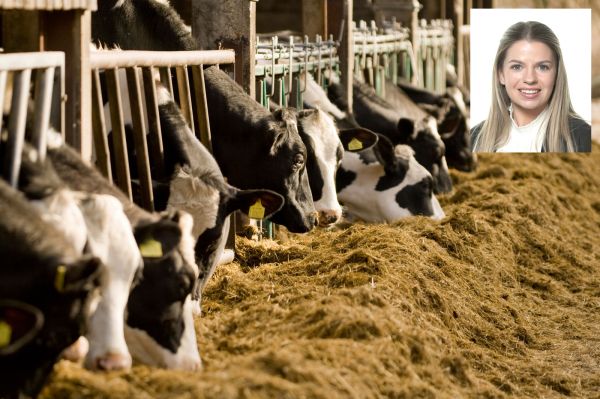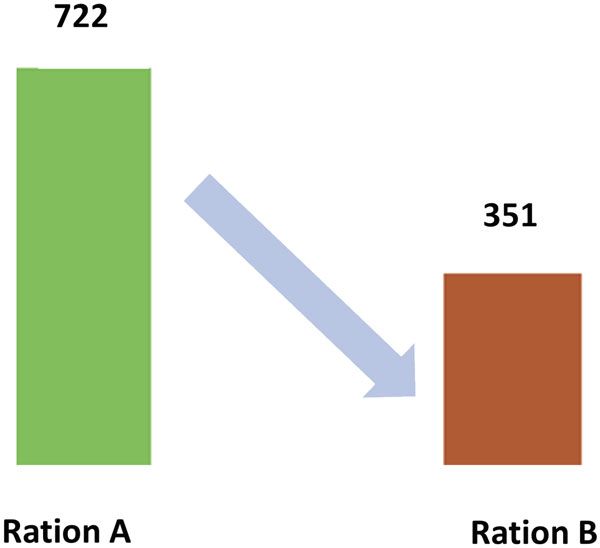Feeding efficiency

There is a lot of confusion around carbon foot-printing and environmental sustainability. When it comes to carbon foot-printing, what does it actually mean, from a farmer’s perspective? Reducing the carbon footprint of milk and indeed meat production is carried out by driving efficiency on farm. There are a range of practical mitigations that can be used on dairy farms to help ensure that emissions from agriculture can be reduced, this includes practical nutrition and management-based practices designed to lower emissions of ammonia and methane.
Dairy emissions
- Carbon footprint of milk produced:
0.82 CO₂ equivalent per kg fat- and protein-corrected milk (FPCM). - Nitrogen use efficiency on the average dairy farm: 28 per cent.
- Major greenhouse gas CH₄ (animal digestion and slurry) and N₂O (manure and fertiliser).
Efficiency
Efficient use of feed means optimising feed inputs and key to that is feeding the cow for performance. Through precision feeding, cows are fed consistently and accurately to match their dry matter requirements, maximising cow performance, while also reducing feed wastage. Necessary adjustments to the diet of dairy cows can be made in real time to proactively ensure optimal nutrition to drive performance in the herd. An improvement in feed efficiency means that more nutrients are utilised for production by the cow with less emissions losses to the environment.
The rumen can account for up to 39 per cent of a typical dairy farm’s carbon footprint. The reason the rumen accounts for so much of the farm’s emissions is that it produces volatile fatty acids (VFAs). VFAs form through rumen fermentation and are essential for providing the animal’s energy supply. They are then used to generate kilogrammes of milk solids. Any undigested feed is wasted and produces gases such as methane. The more efficient the rumen is at creating VFAs, the less methane gas is produced. The type and amount of VFAs produced all depends on the feeds going into the rumen. Keeping the rumen as healthy as possible begins with maintaining a stable rumen pH of 6. Anything less and the rumen can start to show signs of acidosis. Formulating a diet for optimum performance starts with knowing and testing the quality of the feeds being used. Depending on the stage of lactation, the cows will have specific requirements for energy, protein and fibre to produce kilograms of milk solids. By maintaining a healthy functioning rumen year-round, cows avoid dips in milk protein six weeks post-calving and can beat the drop in milk fat when the fibre content drops in grass during the second rotation. These increases in rumen efficiency all lead to optimised milk solid production.

A comparison of two compounds where the carbon footprint of the ration was reduced by over 50 per cent by reducing soya bean meal, and replacing this with Optigen. Source: Alltech.
Planning
Many dairy farms are preparing to dry cows off and are planning for the calving season ahead. With variable forage quality being fed, body condition of cows is proving to be inconsistent across the country. The key to performance in any herd is managing body condition score (BCS). BCS monitoring and controlling BCS are key to a trouble-free calving and a more productive subsequent lactation. Planning ahead by analysing silage to provide a balanced diet based on the silage quality and condition of cows is fundamental to ensuring cows are dried off at the correct BCS. Once the cows are set up with a good body condition score in late lactation, the next stage is to prepare for the dry cow period. While the focus over the coming weeks is managing cow condition, we sometimes forget that the mineral status of the cow in late lactation to drying off will play an important role in the overall health and well-being of cow and the calf growing inside her.
In Ireland, many of our grass silages are deficient in trace minerals. Trace minerals support the cow’s immune system, supporting the immune response during times of stress and thereby improving cow performance. Alltech’s mineral management programme focusses on feeding organic trace minerals (copper, zinc, selenium) and these are better absorbed, stored and utilised by the animal and can be fed at significantly lower levels while still improve animal performance. This approach allows for better management of the animal’s mineral requirements while reducing the impact on the environment. Research has shown that with the supplementation of Alltech’s Bioplex minerals there are improvements in conception rates and dates to first service in the herd (Pino, et al., 2018).
Improving the quality of the silage being fed to cows and youngstock can help reduce the carbon footprint of the farm. Cutting the grass for silage at the correct growth stage and getting it ensiled at the correct time is vital to producing top quality feed. The first step to understanding silage quality is to test the silages you have already made. This can show you what feed value is in the silage for the winter. Silage needs to be tested for dry matter, energy, protein, and fibre. Youngstock require protein to grow and hit target weights for breeding and turn out. Protein in grass silages is between 12-15 per cent. The higher the protein content of the silage, the less imported protein needs to be fed in rations. This will reduce the farms reliance on imported protein sources such as soyabean meal, which is known to have a high carbon footprint.
Alltech’s non-protein nitrogen source for ruminants concentrates the nitrogen fraction of the diet, creating dry matter space for more fibre and energy. The product, called Optigen, is a technology that delivers a sustained release of ammonia to the rumen over time to meet the needs of the microbial population more effectively than conventional protein sources, resulting in:
Increased microbial protein;
Increased fibre digestion; and
Increased efficiency of rumen nitrogen capture.
Unlike other wasteful and potentially risky nitrogen sources, this is a safe and traceable source that increases the efficiency of rumen nitrogen capture, resulting in less nitrogen waste. The Carbon Trust has certified that the replacement of high-carbon ingredients (such as soya) with Optigen significantly reduces the risk of a high carbon footprint.
Through reformulations of a dairy diet with the use of Optigen, the overall crude protein can be reduced whil maximising animal performance. It has a higher soluble crude protein with a better balance of PDIN and PDIE, meaning less nitrogen waste, therefore less energy wasted by the cow. By reducing high carbon footprint ingredients, we can lower the global warming potential of feed, improving the overall dairy farm environmental credentials.
Lowering a farm’s footprint goes with increasing farm efficiency and, therefore, profitability. Through improving farm management practices and embracing new technologies, you can move a step closer to your sustainability targets.




